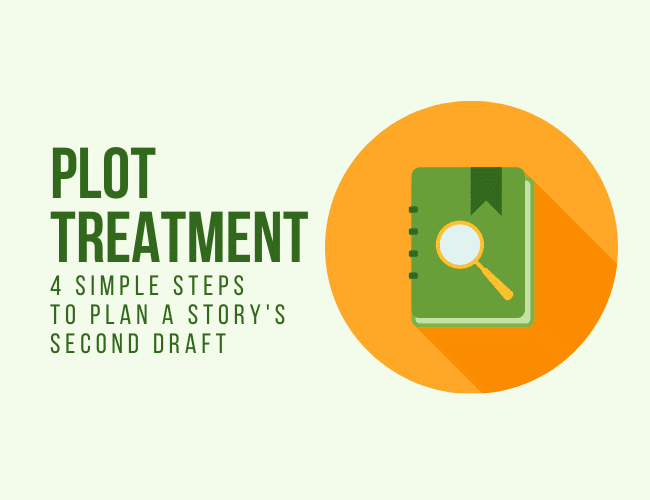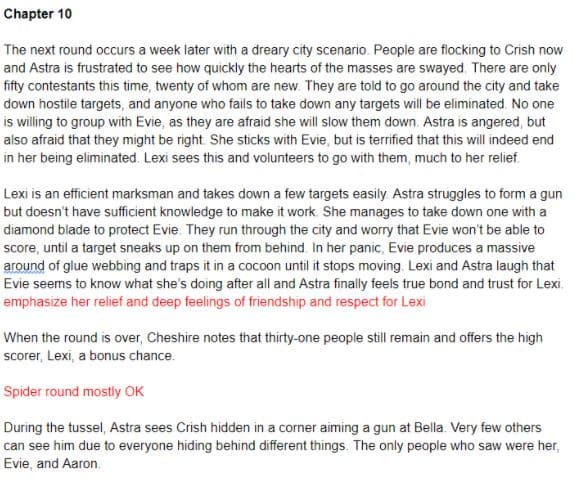First drafts are ugly, as they’re intended to be. Frankly, if your first draft isn’t full of run-on sentences, plot holes, and poorly developed characters, you might be doing something wrong. With the hardest part done, you turn to your second draft—but how do you write a second draft?
To start, you need to write a plot treatment.

The second draft is where your story really comes together. This is where you figure out everything that didn’t work in the first draft and fix it—or treat it. I like the word treat because it looks at the first draft as a patient—it’s not bad, it’s just unwell and needs you to play story doctor and make it better.
Thankfully, the process to improve your story and build a solid foundation for your second draft doesn’t have to be difficult. It can be done easily with a plot treatment.
In this article, you'll learn what a plot treatment is, and why writing a plot treatment can help guide your second draft.
What is a Plot Treatment?
A plot treatment is exactly what it sounds like—a plan to treat your plot.
Take off your author hat for a moment and put on a doctor’s hat. If a patient comes to you and expresses that they are sick? What are the logical steps to take?
First, you would probably want to know their symptoms. What is exactly is wrong with the patient that needs fixing?
Second, you would want to figure out why they’re experiencing the symptoms. A cough and a sneeze could be due to any number of things, just like a plot hole and a poorly paced chapter can happen due to any number of reasons.
Third, you would want to decide what the best medicine is. Every problem has a fix. Or if it doesn’t, then perform surgery and cut it out entirely.
Fourth, you would want to develop a plot treatment plan.
Fixing individual problems doesn’t necessarily address the book as a whole. You wouldn’t want to tell someone to take a bunch of medication without first considering the side effects. You want to be able to look at all the changes at once, decide how they influence each other, eliminate new problems that might have cropped out, and smooth everything out as much as you possibly can.
That final plan is your plot treatment.
4 Simple Steps to Treat Your Story
I’d like to start by showing you a piece from the plot treatment for my novel Headspace.

It’s worth mentioning that the first and second draft of Headspace were very different. The first draft was so awful that I nearly didn’t move onto a second one. Before Headspace, I had never taken a book past the first draft so the idea of doing so was terribly daunting. Not to mention I couldn't find the best way to edit—for me.
It was all pretty discouraging.
But I loved my story, and wanted to give it a real chance. In the end, after some hemming and hawing, along with some experimenting, I came up with my own edit plan—which then resulted in my own plot treatment.
I used three steps to do this.
Step 1: Summarize and Diagnose
Open a new Word document (or whatever it is you use to write). Then, open your first draft.
Read your first draft. Really read it and try to think about what happened in this chapter.
- Is it what you wanted to happen in the chapter?
- Does it do what you need it to do?
- Is something missing?
- Do you wish it flowed differently?
After you reflect on these questions, write a summary of the chapter in your new document. This is not a summary of the chapter as it was written in the first draft, but a summary of how you’d prefer for the first draft to be.
Make note of what works and what doesn’t. This summary can be as long or short as you need, as long as it includes all the details you require to write the second draft.
In my example above, the original chapter ten of Headspace did not take place in a city but on a rooftop with limited space. I wrote this summary with the new setting, keeping some details the same. I used red text to leave notes for myself that aren’t directly part of the summary.
For example, where part of the original text could work in the new draft, I left the note “spider round mostly OK” so I know I can recycle that part. This is a relatively short summary for a chapter since it does include some reused material.
I’ve had chapter summaries go over an entire page because so much changes are needed, as well as summaries that just say “this chapter is OK.”
As you make your changes, try to think about why you’re making the change. This may result in ripple changes to other chapters, and that’s completely fine.
This whole process is what allows you to edit the plot over a few short pages rather than through a 350-page book.
Step 2: Incorporate Revision Notes
You may remember the revision list that you kept when writing your first draft. Now’s the time to break it out. After you’ve finished summarizing your book, take out your list and go down it one item at a time. See how each one incorporates into the new drafts–or doesn’t.
The reason you do this step rather than try to incorporate all the notes initially is because your thought process can and will change as you write the book. Remember what I said about the importance of finishing your story? Your thoughts on your earlier notes will likely change by the time you get to the end of your first draft.
Take a look at each note and decide whether it’s:
- Worth incorporating into the new draft, or
- No longer relevant
In my example above, I wrote a red note to emphasize the protagonist's feelings. This was a note from the revision list and I had decided to keep it because it’s still useful and relevant. Many other notes did not make it in.
Keep in mind that just because you made a note in your revision list, doesn’t mean you absolutely have to find a place for it. A story is a living thing. It changes and evolves as you tell it.
At the end of the day, it’s about picking and choosing what’s best for your book.
Step 3: Smooth Out the Plan
My plot treatments usually end up being about twenty to thirty pages. There is no hard number for how long your plot treatment should be, but you want it to be long enough to include all the details you need and short enough that you can edit the plot without feeling like you’re editing a whole book.
Once you’ve reworked your chapters how you like it and incorporated all the revision notes you deem to be important, put the plot treatment away.
That’s right. Step away from it.
You’ve probably heard people talk about putting away your book for a month and then coming back to it with fresh eyes. A plot treatment is the same. You’ve essentially just written an entire summary of the second draft in a relatively short amount of time. Step away from a few days to give yourself a chance to refresh.
When you come back, read over the entire plot treatment and as yourself the following questions:
- Does the story flow like you want?
- Are there obvious plot holes that still need to be plugged?
- Are the changes made consistent with each other? If not, what needs to be adjusted?
- Are your characters stronger than they were in the first draft? If not, what else needs to be done to strengthen them?
If there is anything else at all that you want fixed plot-wise, now is the time to do it. Fixing something the plot treatment is alot easier than fixing it while writing a book.
Using Your Plot Treatment
With your plot treatment as a guide, writing the second draft is going to be a lot easier. You will likely adhere to your plot treatment a lot closer than you did your scene list, because your plot treatment is much tighter, more structured, and better thought out.
But do you have to stick strictly to your plot treatment?
Of course not. The example above from my novel actually isn’t very close to how that chapter turned out in the end. I ended up switching some of the characters and interactions and changing up the relationship dynamics quite a bit.
Having the guide was very helpful as a starting point. In fact, in my current book, Master of the Arena, I went through this process multiple times—draft one, plot treatment, draft two, plot treatment again, draft three, plot treatment again. Every iteration will get you closer to the book you’re trying to write and every draft will be a little easier.
Take a deep breathe, and try this approach for your own story—or try it and then adapt it to model a story treatment that works for you.
How do you prepare for a second draft? What strategies do you use to write a story treatment? Let us know in the comments.
PRACTICE
Grab your completed first draft—or even just a first draft in progress.
Look at the first chapter by writing down in simple paragraphs how you would like the first chapter to go, incorporating what you already wrote plus any changes.
Remember that this is how you would like the chapter to be in the second draft. Take no more than fifteen minutes to do this. You will find that the exercise helps you get into an editing mindset and think about how the next draft should look.
When you're done, share your reflections in the practice box below. If you're up for it, spend some time commenting on other reflections—maybe we can help each other sort out what's missing!
J. D. Edwin is a daydreamer and writer of fiction both long and short, usually in soft sci-fi or urban fantasy. Sign up for her newsletter for free articles on the writer life and updates on her novel, find her on Facebook and Twitter (@JDEdwinAuthor), or read one of her many short stories on Short Fiction Break literary magazine.
I am just beginning the second week of my first draft in the 100 Day Course. I did reread my first 6800 words though.